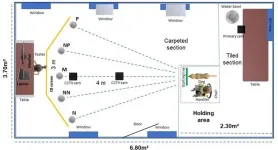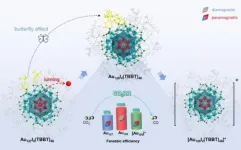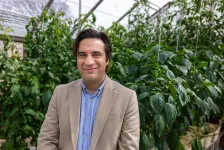EMBARGOED FOR RELEASE UNTIL 4:00 P.M. ET, WEDNESDAY, APRIL 9, 2025
MINNEAPOLIS — Heavy drinkers who have eight or more alcoholic drinks per week have an increased risk of brain lesions called hyaline arteriolosclerosis, signs of brain injury that are associated with memory and thinking problems, according to a study published on April 9, 2025, online in Neurology®, the medical journal of the American Academy of Neurology. The study does not prove that heavy drinking causes brain injury; it only shows an association.
Hyaline arteriolosclerosis is a condition that causes the small blood vessels to narrow, becoming thick and stiff. This makes it harder for blood to flow, which can damage the brain over time. It appears as lesions, areas of damaged tissue in the brain.
“Heavy alcohol consumption is a major global health concern linked to increased health problems and death,” said study author Alberto Fernando Oliveira Justo, PhD, of University of Sao Paulo Medical School in Brazil. “We looked at how alcohol affects the brain as people get older. Our research shows that heavy alcohol consumption is damaging to the brain, which can lead to memory and thinking problems."
The study included 1,781 people who had an average age of 75 at death. All had brain autopsies.
Researchers examined brain tissue to look for signs of brain injury including tau tangles and hyaline arteriolosclerosis. They also measured brain weight and the height of each participant.
Family members answered questions about participants’ alcohol consumption.
Researchers then divided the participants into four groups: 965 people who never drank, 319 moderate drinkers who had seven or fewer drinks per week; 129 heavy drinkers who had eight or more drinks per week; and 368 former heavy drinkers. Researchers defined one drink as having 14 grams of alcohol, which is about 350 milliliters (ml) of beer, 150 ml of wine or 45 ml of distilled spirits.
Of those who never drank, 40% had vascular brain lesions. Of the moderate drinkers, 45% had vascular brain lesions. Of the heavy drinkers, 44% had vascular brain lesions. Of the former heavy drinkers, 50% had vascular brain lesions.
After adjusting for factors that could affect brain health such as age at death, smoking and physical activity, heavy drinkers had 133% higher odds of having vascular brain lesions compared to those who never drank, former heavy drinkers had 89% higher odds and moderate drinkers, 60%.
Researchers also found heavy and former heavy drinkers had higher odds of developing tau tangles, a biomarker associated with Alzheimer’s disease, with 41% and 31% higher odds, respectively.
Former heavy drinking was associated with a lower brain mass ratio, a smaller proportion of brain mass compared to body mass, and worse cognitive abilities. No link was found between moderate or heavy drinking and brain mass ratio or cognitive abilities.
Justo noted that, in addition to brain injuries, impaired cognitive abilities were observed only in former drinkers.
Researchers also found that heavy drinkers died an average of 13 years earlier than those who never drank.
“We found heavy drinking is directly linked to signs of injury in the brain, and this can cause long-term effects on brain health, which may impact memory and thinking abilities,” said Justo. "Understanding these effects is crucial for public health awareness and continuing to implement preventive measures to reduce heavy drinking."
A limitation of the study was that it did not look at participants before death and did not have information on the duration of alcohol consumption and cognitive abilities.
The study was supported by The São Paulo Research Foundation.
Discover more about brain health at BrainandLife.org, from the American Academy of Neurology. This resource also offers a magazine, podcast, and books that connect patients, caregivers and anyone interested in brain health with the most trusted information, straight from the world’s leading experts in brain health. Follow Brain & Life® on Facebook, X, and Instagram.
The American Academy of Neurology is the leading voice in brain health. As the world’s largest association of neurologists and neuroscience professionals with more than 40,000 members, the AAN provides access to the latest news, science and research affecting neurology for patients, caregivers, physicians and professionals alike. The AAN’s mission is to enhance member career fulfillment and promote brain health for all. A neurologist is a doctor who specializes in the diagnosis, care and treatment of brain, spinal cord and nervous system diseases such as Alzheimer's disease, stroke, concussion, epilepsy, Parkinson's disease, multiple sclerosis, headache and migraine.
Explore the latest in neurological disease and brain health, from the minds at the AAN at AAN.com or find us on Facebook, X, Instagram, LinkedIn, and YouTube.
END
How does heavy drinking affect the brain?
Eight or more drinks per week linked to signs of injury in the brain
2025-04-09
(Press-News.org)
ELSE PRESS RELEASES FROM THIS DATE:
Father with Alzheimer’s? You may be more at risk of brain changes
2025-04-09
EMBARGOED FOR RELEASE UNTIL 4:00 P.M. ET, WEDNESDAY, APRIL 9, 2025
MINNEAPOLIS — While some studies have suggested that having a mother with Alzheimer’s disease may put you more at risk of developing the disease, a new study finds that having a father with the disease may be tied to a greater spread of the tau protein in the brain that is a sign of the disease, according to a study published on April 9, 2025, online in Neurology®, the medical journal of the American Academy of Neurology. The study does not prove that having a father with Alzheimer’s results in these brain changes; it only shows an association.
The study also showed ...
MSU research: Eating brown rice increases exposure to arsenic compared to white rice
2025-04-09
Why this matters:
Arsenic levels in brown rice were found to be higher for U.S. consumers than in white rice, despite people often looking to brown rice as a healthier alternative.
There is significant arsenic risk for U.S. children under 5 who consume brown rice, as arsenic is a toxic chemical element that can lead to health problems.
Arsenic levels in U.S.-grown rice were found to be considerably lower than rice grown outside the country, suggesting there is concern to U.S. consumers who eat rice grown outside the country.
EAST LANSING, Mich. – Whether you buy rice at the grocery store or order a side of it while ...
Do “optimistic” versus “pessimistic” medical detection dogs perform differently?
2025-04-09
A new, exploratory study has revealed statistical links between the performance of medical detection dogs and their scores on behavioral and affective tests, finding that more “optimistic” dogs tended to perform better overall on detection tasks, but “pessimistic” dogs had higher scent detection specificity. Sharyn Bistre Dabbah of the University of Bristol, U.K., and colleagues present these findings in the open-access journal PLOS One on April 9, 2025.
Animal researchers commonly use a method called judgment bias testing to help assess animals’ emotional states. For example, dogs may first be trained to associate a specific location in a room ...
Multi-virus wastewater surveillance shows promise at smaller, site-specific scales
2025-04-09
In a new study, wastewater surveillance for multiple pathogens at five different sites identified local trends that were not captured in larger surveillance programs, and some sites used the data to inform efforts to prevent disease spread. Jay Bullen of Untap Health in London, U.K., Charlotte Hammer of the University of Cambridge and colleagues present these findings in the open-access journal PLOS Global Public Health.
People with viral infections produce waste containing viral RNA that ends up in wastewater ...
In addition to participation in school-based extracurricular activities, U.S. adolescents who participate in faith-based or community-based extracurricular activities may be more likely to identify th
2025-04-09
Scientists from Yale University report that in addition to participation in school-based extracurricular activities, U.S. adolescents who participate in faith-based or community-based extracurricular activities may be more likely to identify the risks of binge-drinking behavior, which could be an important consideration when developing preventions for excessive alcohol consumption.
###
Article URL: https://plos.io/4jHh7Dd
Article Title: Adolescent extracurricular activities and perception of risk of harm from binge drinking
Author Countries: United States
Funding: This study was financially supported by the National Institute on Drug Abuse (NIDA) (https://nida.nih.gov) ...
A new smartphone-sized device can test for tuberculosis. Here’s why that matters for children
2025-04-09
Tulane University researchers have developed a first-of-its-kind handheld diagnostic device that can deliver rapid, accurate tuberculosis diagnoses in under an hour, according to a study published in Science Translational Medicine.
The smartphone-sized, battery-powered lab-in-tube assay (LIT) provides a cost-effective tool that can improve TB diagnoses, particularly in resource-limited rural areas where health care facilities and lab equipment are less accessible. Over 90% of new TB cases occur in low- and middle-income countries.
This point-of-care device is the first to detect Mycobacterium tuberculosis (Mtb) DNA in saliva, in addition to blood and sputum samples. Saliva is ...
Scientists uncover spin–catalytic activity correlation in single-atom and -electron tailored gold nanoclusters
2025-04-09
Recently, a team of researchers from the Hefei Institutes of Physical Science of the Chinese Academy of Sciences (CAS) has consecutively removed the innermost atom and the outermost electron of a gold nanoparticle—without disturbing its overall structure. This precise manipulation allowed them to probe how the magnetic spin of the material influences its catalytic activity.
The work, led by Prof. WU Zhikun in collaboration with Prof. YANG from the Institute of Process Engineering, CAS and Prof. TANG from Chongqing University, ...
New research further translates the language of the genome
2025-04-09
New research has uncovered more about the complexity of human gene regulation by identifying certain sequences of proteins called transcription factors that bind to DNA and regulate the expression of human genes.
Published today (9 April) in Nature, researchers from the Wellcome Sanger Institute, the University of Cambridge and their collaborators explored how DNA-guided transcription factors interact with each other.
This research adds to the groundwork of understanding the complex language of the gene regulatory code, and how DNA sequence patterns located close to our genes influence human development and disease risk.
Each ...
How much food can the world grow? International team calls for new yield potential estimates
2025-04-09
An international team of agronomists is calling for a new approach to estimate crop yield potential and gaps — information that is critical in planning how to meet growing food demand.
University of Nebraska–Lincoln researchers made major contributions to the study, published online April 8 in the journal Nature Food.
“We are in a race to feed the world and to try to feed the population with the available agricultural land that we have,” said Patricio Grassini, Sunkist Distinguished Professor of Agronomy and one of the paper’s authors.
To ...
Could LLMs help design our next medicines and materials?
2025-04-09
CAMBRIDGE, MA – The process of discovering molecules that have the properties needed to create new medicines and materials is cumbersome and expensive, consuming vast computational resources and months of human labor to narrow down the enormous space of potential candidates.
Large language models (LLMs) like ChatGPT could streamline this process, but enabling an LLM to understand and reason about the atoms and bonds that form a molecule, the same way it does with words that form sentences, has presented a scientific stumbling block.
Researchers ...
LAST 30 PRESS RELEASES:
University of Oklahoma researcher awarded funding to pursue AI-powered material design
Exploring how the visual system recovers following injury
Support for parents with infants at pediatric check-ups leads to better reading and math skills in elementary school
Kids’ behavioral health is a growing share of family health costs
Day & night: Cancer disrupts the brain’s natural rhythm
COVID-19 vaccination significantly reduces risk to pregnant women and baby
The role of vaccination in maternal and perinatal outcomes associated with COVID-19 in pregnancy
Mayo Clinic smartwatch system helps parents shorten and defuse children's severe tantrums early
Behavioral health spending spikes to 40% of all children’s health expenditures, nearly doubling in a decade
Digital cognitive behavioral treatment for generalized anxiety disorder
Expenditures for pediatric behavioral health care over time and estimated family financial burden
Air conditioning in nursing homes and mortality during extreme heat
The Alps to lose a record number of glaciers in the next decade
What makes a good proton conductor?
New science reporting guide published for journalists in Bulgaria
New international study reveals major survival gaps among children with cancer
New science reporting guide published for journalists in Turkey
Scientists develop a smarter mRNA therapy that knows which cells to target
Neuroanatomy-informed brain–machine hybrid intelligence for robust acoustic target detection
Eight SwRI hydrogen projects funded by ENERGYWERX
The Lundquist Institute and its start-up company Vitalex Biosciences Announces Strategic Advancement of Second-Generation fungal Vaccine VXV-01 through Phase 1 Trials under $40 Million Competitive Con
Fine particles in pollution are associated with early signs of autoimmune disease
Review article | Towards a Global Ground-Based Earth Observatory (GGBEO): Leveraging existing systems and networks
Penn and UMich create world’s smallest programmable, autonomous robots
Cleveland researchers launch first major study to address ‘hidden performance killer’ in athletes
To connect across politics, try saying what you oppose
Modulating key interaction prevents virus from entering cells
Project explores barriers to NHS career progression facing international medical graduates
Jeonbuk National University researchers explore the impact of different seasonings on the flavor perception of Doenjang soup
Two Keck Medicine of USC Hospitals named Leapfrog Top Teaching Hospitals
[Press-News.org] How does heavy drinking affect the brain?Eight or more drinks per week linked to signs of injury in the brain



